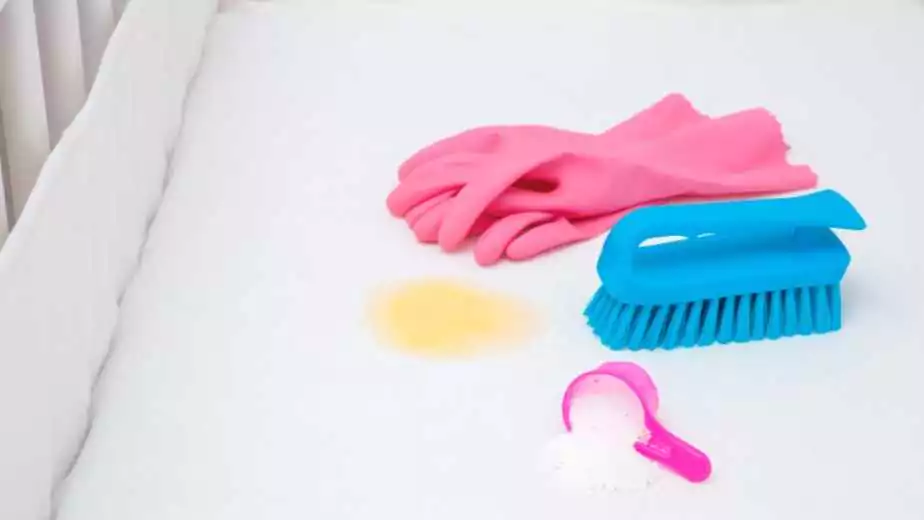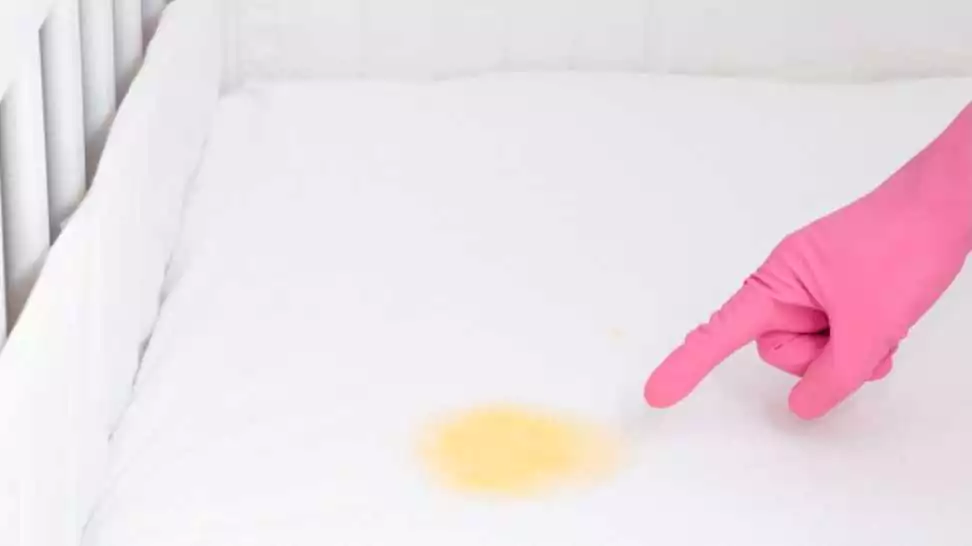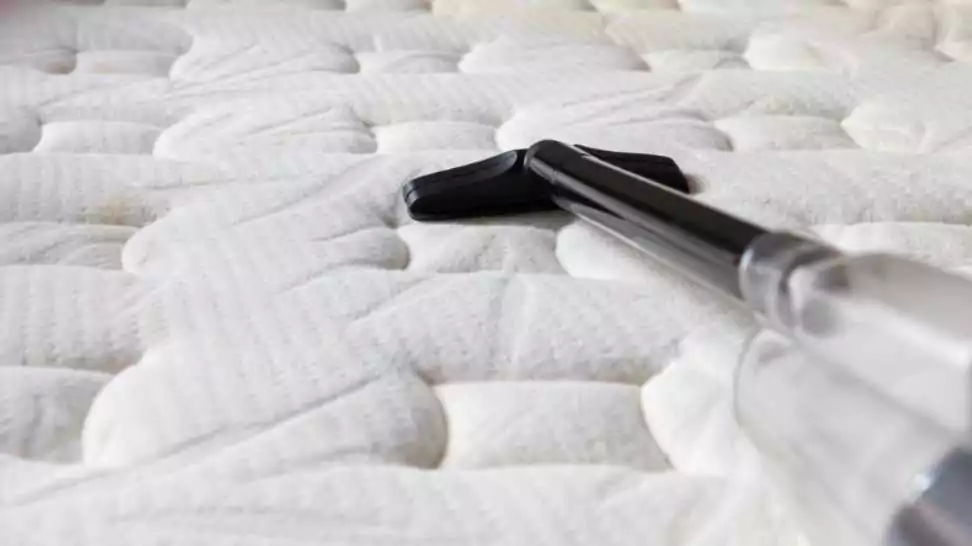How To Clean A Crib Mattress? Step-by-Step

Entering the world of parenthood brings both joy and new duties, with one of the key tasks being creating a safe and clean sleeping area for your infant. Central to this is the crib mattress, a vital part of your baby’s daily life. Keeping it clean goes beyond mere tidiness; it’s essential for your child’s health, safeguarding them from unwanted germs, allergens, and irritants.
This guide aims to thoroughly outline the best practices for maintaining a crib mattress. We’ll cover everything from how often to clean it to selecting the safest and most effective cleaning methods. By the end of this guide, you will have all the information necessary to provide your little one a secure, hygienic, and comfortable sleeping environment.
We will explore how to clean a crib mattress, including routine maintenance, managing spills and stains, the importance of using gentle, baby-friendly cleaning products, and strategies for ensuring ongoing cleanliness and safety.
Embark with us on this journey to secure the ideal sleep setting for your baby, beginning with the cornerstone of their rest – the crib mattress.
1 Understanding Your Crib Mattress
Types of Crib Mattresses

Before diving into cleaning techniques, it’s crucial to understand the type of crib mattress you have, as the material significantly influences the cleaning process. Generally, crib mattresses come in three types: foam, innerspring, and organic.
- Foam Mattresses: These are lightweight and made from polyurethane foam. Their sponginess requires a gentle approach to avoid soaking the mattress during cleaning.
- Innerspring Mattresses: These feature coils covered with padding and fabric. They are heavier and often more durable. The cleaning process must ensure that the layers covering the springs do not retain moisture.
- Organic Mattresses: Made from natural materials like cotton, wool, or coconut fibres, these mattresses are eco-friendly and hypoallergenic. Special care is needed as harsh chemicals can damage the natural fibres.
Material Composition and Cleaning Methods
The material composition of your crib mattress not only determines its comfort and support but also the appropriate cleaning methods:
- Foam Mattresses: Use minimal water and gentle cleaning solutions to avoid saturating the foam, which can lead to mould growth.
- Innerspring Mattresses: Focus on surface cleaning without penetrating the inner layers. Use mild detergents and ensure thorough drying.
- Organic Mattresses: Often require specific cleaning agents that are chemical-free and natural to maintain the integrity of the organic materials.
Understanding Manufacturer’s Instructions
Each crib mattress comes with a set of cleaning instructions and recommendations from the manufacturer. These guidelines are crucial for several reasons:
- Preserving Warranty: Following the manufacturer’s instructions ensures that you don’t inadvertently void the warranty.
- Material Safety: Different materials react differently to cleaning agents and methods. The manufacturer’s instructions help you avoid damaging the mattress.
- Effective Cleaning: Manufacturers provide recommendations based on the mattress’s design and materials, ensuring that you clean effectively without causing harm.
2 Preparing for Cleaning
Before you begin the cleaning process, it’s important to gather all necessary supplies and prepare a safe and suitable cleaning area. This preparation ensures that the cleaning process is efficient, effective, and safe for both you and the mattress.
Necessary Cleaning Supplies
Having the right cleaning supplies at hand is essential. Here’s a list of items you’ll typically need:
- Gentle Detergents: Choose mild, baby-safe detergents that are free from harsh chemicals and fragrances to prevent irritation to your baby’s sensitive skin.
- Baking Soda: An excellent natural deodorizer, baking soda is great for removing odours from the mattress.
- Vacuum Cleaner with Upholstery Attachment: This helps in removing dust, dirt, and allergens from the surface and crevices of the mattress.
- Soft Cleaning Cloths or Sponges: Use these for applying cleaning solutions and wiping down the mattress.
- Cold Water: Have plenty of cold water available for diluting detergents and rinsing.
- Dry Towels: Useful for blotting out moisture during and after the cleaning process.
Creating a Safe and Suitable Cleaning Area
Choose a cleaning area that is well-ventilated and spacious enough to easily manoeuvre around the mattress. Consider these tips:
- Outdoor Cleaning: If weather permits, cleaning outdoors (like on a sunny patio) can be ideal for air drying and ventilation.
- Indoor Cleaning: If cleaning indoors, choose a room with good air circulation. Open windows to allow fresh air to circulate and help with drying.
Safety Precautions
Safety is paramount, especially when dealing with cleaning products around babies. Keep these precautions in mind:
- Chemical Safety: Always use baby-safe, non-toxic cleaning products. If unsure, check the product labels for any warnings.
- Ventilation: Ensure good air circulation to avoid inhaling any fumes from cleaning agents.
- Protective Gear: Consider wearing gloves, especially if you have sensitive skin or are using a new cleaning product.
- Keeping Baby Away: Ensure your baby is in a safe place, away from the cleaning area, to avoid exposure to dust and cleaning agents.
- Testing Products: Before using any cleaning product, do a spot test in an inconspicuous area to check for any adverse reactions.
3 Routine Cleaning Steps
Regular cleaning of your baby’s crib mattress is crucial for maintaining a hygienic sleeping environment. Here’s a step-by-step guide on how to conduct routine cleaning effectively:
Step 1: Vacuuming the Mattress
- If your mattress has a removable cover, take it off and wash it according to the manufacturer’s instructions.
- Attach the upholstery attachment to your vacuum cleaner. Thoroughly vacuum both sides of the mattress, paying special attention to seams and crevices where dust and allergens may accumulate.
Step 2: Spot Cleaning Stains
- Look for any spots or stains on the mattress.
- Mix a small amount of mild, baby-safe detergent with cold water.
- Dip a soft cloth or sponge into the solution and gently dab at the stain. Avoid rubbing harshly, as this can push the stain deeper into the mattress.
- After the stain is lifted, dab the area with a cloth dampened with cold water to remove any soap residue.
- Use a dry towel to blot the area and remove as much moisture as possible.
Step 3: Wiping Down the Mattress
- After spot cleaning, use a damp cloth to lightly wipe down the entire surface of the mattress.
- Be sure not to soak the mattress. The cloth should be just damp enough to clean the surface without saturating the mattress.
- Allow the mattress to air dry completely before putting the cover back on or using it. If possible, place the mattress in a sunny, well-ventilated area to aid in drying.
Frequency of Routine Cleaning
The frequency of routine cleaning can depend on various factors like the baby’s age, health conditions (like allergies), and any incidents of spills or diaper leaks. As a general guideline:
- Weekly Vacuuming: To keep dust and allergens at bay, vacuum the mattress weekly.
- Spot Cleaning: Perform spot cleaning as soon as stains occur to prevent them from setting in.
- Overall Wipe-Down: Wiping down the mattress with a damp cloth can be done monthly or as needed.
4 Deep Cleaning Your Crib Mattress
While routine cleaning is essential for maintaining a clean crib mattress, deep cleaning is necessary for ensuring long-term hygiene and safety. This section covers when and why deep cleaning is needed and provides a step-by-step guide.
When and Why Deep Cleaning is Necessary
Deep cleaning should be considered in the following scenarios:
- Seasonal Cleaning: At least once every season remove deep-set dirt and allergens.
- After Illness: To eliminate germs and bacteria when your baby recovers from an illness.
- Visible Dirt and Stains: When regular spot cleaning isn’t enough for stubborn stains or dirt.
- Odour Removal: To remove persistent odours that aren’t eliminated through routine cleaning.
Deep cleaning is crucial for removing accumulated dust, mites, and potential mould or mildew, which could be harmful to your baby’s health.
Step-by-Step Guide on Deep Cleaning
Remove and Wash Mattress Cover:
- If your mattress has a removable cover, take it off and wash it according to the manufacturer’s instructions.
Using Baking Soda for Odour Removal:
- Generously sprinkle baking soda over the entire surface of the mattress.
- Let it sit for a few hours or, ideally, overnight. Baking soda absorbs odours and draws out moisture.
- Vacuum the baking soda thoroughly.
Applying a Gentle Cleaning Solution:
- Prepare a solution using mild detergent and warm water.
- Using a soft cloth, gently scrub the mattress surface. Be cautious not to soak the mattress.
- Focus on areas with visible stains or dirt, using a soft-bristled brush if necessary.
Rinsing:
- Wipe the mattress with a damp cloth to remove any soap residue.
- Avoid over-wetting the mattress.
Ensuring Proper Drying:
- Dry the mattress in a well-ventilated area, ideally in direct sunlight.
- Ensure the mattress is completely dry before use to prevent mould and mildew formation.
- Consider using fans or a dehumidifier to speed up the drying process.
5 Stain Removal Tips

Dealing with stains on a crib mattress is an inevitable part of parenting. Understanding how to effectively remove different types of stains can help maintain the mattress’s hygiene and longevity. Here, we’ll explore common types of stains found on crib mattresses and share safe and effective methods for their removal, including natural alternatives to commercial stain removers.
Types of Common Stains
- Diaper Leaks: These are probably the most common and can leave both wet spots and odours.
- Spit-Up: Acidic in nature, spit-up can cause discolouration and unpleasant odours.
- Food and Drink Spills: If your toddler eats or drinks in bed, these spills can create stubborn stains.
- Sweat: Over time, sweat can lead to yellowish stains.
Safe and Effective Methods for Removing Different Types of Stains
Diaper Leaks:
- Blot the area with a dry towel to absorb as much liquid as possible.
- Apply a mixture of baking soda and water to neutralize the odour and absorb moisture.
- After a few hours, vacuum the baking soda and spot clean with a mild detergent.
Spit-Up:
- Clean the area immediately to prevent the acid from damaging the mattress.
- Use a damp cloth with a mild detergent to dab the stain.
- Rinse with a damp cloth and dry thoroughly.
Food and Drink Spills:
- Remove any solid residue with a spoon or dull knife.
- Blot the area with a mixture of water and mild detergent.
- Rinse with a clean, damp cloth and blot dry.
Sweat Stains:
- Create a solution of equal parts water and vinegar.
- Apply the solution to the stain and let it sit for 15-20 minutes.
- Rinse with a damp cloth and blot dry.
Natural Alternatives to Commercial Stain Removers
- Vinegar and Water Solution: Works well for urine and sweat stains due to its natural disinfectant properties.
- Baking Soda: Excellent for odour removal and mild stains.
- Lemon Juice: Acts as a natural bleaching agent for lighter fabrics, useful for lightening stains.
- Corn starch: Effective for oily stains, as it absorbs the oil from fabrics.
When using any of these methods, it’s important to:
- Always blot rather than rub to prevent the stain from spreading.
- Test the cleaning solution on a small, inconspicuous area first to ensure it doesn’t damage the mattress.
- Ensure the mattress is completely dry before use to prevent mould and mildew growth.
Stain removal can be a challenging task, but with these tips and tricks, you can keep your baby’s crib mattress clean and fresh, ensuring a safe and hygienic sleep environment.
6 Maintaining a Clean Crib Mattress
To ensure your baby’s crib mattress remains in optimal condition, regular maintenance is key. This not only extends the life of the mattress but also guarantees a safe and healthy sleeping environment for your child. Here are some essential tips for maintaining a clean crib mattress, the benefits of using mattress protectors, and the importance of air circulation.

Tips for Regular Maintenance
- Use Washable Covers: Invest in a good quality, washable mattress cover. This will protect the mattress from spills and stains and can be easily cleaned.
- Rotate and Flip the Mattress: Regularly rotating and flipping the mattress can prevent uneven wear and extend its lifespan.
- Avoid Harsh Chemicals: When cleaning, use mild detergents and avoid harsh chemicals that can break down the mattress materials over time.
- Immediate Attention to Spills: Clean spills and stains immediately to prevent them from setting in and causing odour or mildew.
- Regular Vacuuming: Vacuum the mattress regularly to remove dust, dirt, and potential allergens.
Using Mattress Protectors and Their Benefits
Mattress protectors are a worthwhile investment for several reasons:
- Protection Against Spills and Stains: They provide a waterproof layer, protecting the mattress from diaper leaks, spit-up, and other spills.
- Preventing Allergens: Protectors can help shield against dust mites and other allergens.
- Ease of Cleaning: Mattress protectors are typically machine washable, making it much easier to maintain a clean sleeping environment.
- Extending Mattress Life: By protecting the mattress from moisture and wear, protectors can significantly extend its lifespan.
Importance of Air Circulation

Proper air circulation is crucial for preventing the build up of mould and mildew, which thrive in moist environments. Here’s how to achieve good air circulation:
- Positioning: Ensure the crib and mattress are positioned in a way that allows air to circulate freely around and under the mattress.
- Regular Air-Outs: Occasionally leave the mattress in a well-ventilated area or near an open window to air out.
- Use Slatted Bed Bases: If possible, use a crib with slatted sides and a slatted bed base for improved airflow.
- Humidity Control: In humid environments, consider using a dehumidifier to maintain optimal room humidity levels.
7 Safety Considerations
When cleaning and maintaining a crib mattress, safety is of the utmost importance. A safe mattress remains firm, clean, and free from harmful chemicals. In this section, we will discuss key safety considerations to keep in mind during and after the cleaning process.
Ensuring the Mattress Remains Firm

- Avoid Over-Soaking: When cleaning, it’s crucial to prevent the mattress from getting overly soaked. Excessive moisture can compromise the firmness of the mattress, which is essential for safe baby sleep.
- Proper Drying: Ensure the mattress is completely dry before using it again. A damp mattress can soften over time, posing a risk for your baby.
- Checking Mattress Firmness: Regularly press down on various areas of the mattress to check for any loss of firmness. A firm mattress is vital for preventing SIDS (Sudden Infant Death Syndrome) related risks.
Avoiding Harsh Chemicals
- Always opt for mild, non-toxic cleaners. Avoid products with harsh chemicals, strong fragrances, or toxic ingredients, as these can be harmful to your baby’s sensitive skin and respiratory system.
- Consider using natural cleaning agents like baking soda and vinegar, which are effective and safe for baby environments.
- Be vigilant about reading product labels to ensure they are safe for use on baby items.
Checking for Signs of Wear and Tear

- After each cleaning, inspect the mattress for any signs of wear and tear. Look for tears, cracks, and any areas where the internal material may be exposed.
- Regularly check the mattress for any signs of degradation, especially if it’s been in use for a long time.
- If you notice significant wear and tear, or if the mattress no longer retains its firmness, it’s time to consider replacing it to ensure your baby’s safety.
8 Wrapping Up
Maintaining a clean crib mattress is crucial for your baby’s health and safety, going beyond basic cleanliness to ensure a hygienic, allergen-free environment. Regularly adhering to the cleaning practices outlined in this guide is key to safeguarding your little one’s well-being.
A consistent cleaning routine, including both regular vacuuming and spot cleaning, as well as periodic deep cleans and safety checks, is vital to keep the mattress in top condition and safe for use. The effort invested in maintaining the crib mattress significantly impacts your baby’s health, comfort, and overall development.
In summary, this guide serves as a valuable tool in your parenting journey. By focusing on the cleanliness and upkeep of your baby’s crib mattress, you’re creating a safe, nurturing space conducive to their growth and healthy sleep.
Community Q&A
About This Article
This article has been viewed 98 times.



